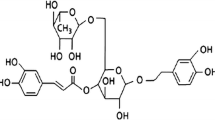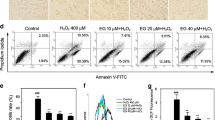Abstract
Z-ligustilide (Z-LIG) is the primary lipophilic compound of the Chinese medicine Danggui (Radix Angelica sinensis). Previous studies demonstrated that Z-LIG had significant neuroprotective potential in both transient and permanent cerebral ischemia, possibly through antioxidant and anti-apoptotic mechanisms. The present study examined the mechanisms of Z-LIG on hydrogen peroxide (H2O2)-induced injury in PC12 cells. Following exposure of the cells to H2O2 (500 μM), a significant reduction in cell survival and total antioxidant capacity (TAC), as well as increased intracellular reactive oxygen species (ROS), were observed. In addition, H2O2 treatment significantly upregulated Bax expression, cleaved-caspase 3, and cytosolic cytochrome-c, and decreased Bcl-2 protein levels. Pretreatment of the cells with Z-LIG (0.1, 1.0, 2.5, or 5.0 μg/ml) significantly attenuated H2O2-induced cell death, attenuated increased intracellular ROS levels, and decreased Bax expression, cleaved-caspase 3, and cytochrome-c. Further, Z-LIG improved cellular TAC and concentration-dependently upregulated Bcl-2 expression. These results demonstrate that Z-LIG has a pronounced protective effect against H2O2-induced cytotoxicity, at least partly through improving cellular antioxidant defense and inhibiting the mitochondrial apoptotic pathway. These findings suggest that Z-LIG may be useful in the treatment of neurodegenerative disorders in which oxidative stress and apoptosis are mainly implicated.




Similar content being viewed by others
References
Berker KI, Gueclue K, Tor I, Apak R (2007) Comparative evaluation of Fe (III) reducing power-based antioxidant capacity assays in the presence of phenanthroline, batho-phenanthroline (FRAP), and ferricyanide reagents. Talanta 72:1157–1165
Bradford M (1976) A rapid and sensitive method for the quantitation of microgram quantities of protein utilizing the principle of protein-dye binding. Anal Biochem 72:248–254
Buttke TM, Sandstrom PA (1994) Oxidative stress as a mediator of apoptosis. Immunol Today 15:7–10
Cheeseman KH (1993) Tissue injury by free radicals. Toxicol Ind Health 9:39–51
Delanty N, Dichter MA (2000) Antioxidant therapy in neurologic disease. Arch Neurol 57:1265–1270
Du J, Bai B, Kuang X, Yu Y, Wang C, Ke Y, Xu Y, Tzang AH, Qian ZM (2006) Ligustilide inhibits spontaneous and agonists- or K+ depolarization-induced contraction of rat uterus. J Ethnopharmacol 108:54–58
Du J, Yu Y, Ke Y, Wang C, Zhu L, Qian ZM (2007) Ligustilide attenuates pain behavior induced by acetic acid or formalin. J Ethnopharmacol 112:211–214
Gilgun-Sherki Y, Rosenbaum Z, Melamed E, Offen D (2002) Antioxidant therapy in acute central nervous system injury: current state. Pharmacol Rev 54:271–284
Götz ME, Künig G, Riederer P, Youdim MB (1994) Oxidative stress: free radical production in neuronal degeneration. Pharmacol Ther 63:37–122
Halliwell B (1992) Reactive oxygen species and the central nervous system. J Neurochem 59:1609–1623
Halliwell B, Gutteridge JMC, Cross CE (1992) Free radicals, antioxidants, and human disease: where are we now? J Lab Clin Med 119:598–620
Hu CY, Ding XL (2003) Extraction, isolation and structure identification of ligustilide from Angelica sinensis. J Wuxi Univ Light Ind 22:69–71
Kuang X, Yao Y, Du JR, Liu YX, Wang CY, Qian ZM (2006) Neuroprotective role of Z-ligustilide against forebrain ischemic injury in ICR mice. Brain Res 1102:145–153
Maroto R, Perez-Polo JR (1997) BCL-2-related protein expression in apoptosis: oxidative stress versus serum deprivation in PC12 cells. J Neurochem 69:514–523
Matsumoto K, Kohno S, Ojima K, Tezuka Y, Kadota S, Watanabe H (1998) Effects of methylenechloride-soluble fraction of Japanese Angelica root extract, ligustilide and butylidenephthalide, on pentobarbital sleep in group-housed and socially isolated mice. Life Sci 62:2073–2082
Peng HY, Du JR, Zhang GY, Kuang X, Liu YX, Qian ZM, Wang CY (2007) Neuroprotective effect of Z-ligustilide against permanent focal ischemic damage in rats. Biol Pharm Bull 30:309–312
Pias EK, Aw TY (2002) Early redox imbalance mediates hydroperoxide-induced apoptosis in mitotic competent undifferentiated PC12 cells. Cell Death Differ 9:1007–1016
Richardson JS, Subbarao KV, Ang LC (1992) On the possible role of iron-induced free radical peroxidation in neural degeneration in Alzheimer’s disease. Ann N Y Acad Sci 648:326–327
Saito Y, Nishio K, Ogawa Y, Kinumi T, Yoshida Y, Masuo Y, Niki E (2007) Molecular mechanisms of 6-hydroxydopamine-induced cytotoxicity in PC12 cells: involvement of hydrogen peroxide-dependent and -independent action. Free Radic Biol Med 42:675–685
Selkoe DJ (1994) Cell biology of the amyloid beta-protein precursor and the mechanism of Alzheimer’s disease. Annu Rev Cell Biol 10:373–403
Sugawara T, Noshita N, Lewen A, Gashe Y, Ferrand-Drake M, Fujimura M, Morita-Fujimura Y, Chan PH (2002) Overexpression of copper/zinc superoxide dismutase in transgenic rats protects vulnerable neurons against ischemia damage by blocking the mitochondrial pathway of caspase activation. J Neurosci 22:209–217
Tao JY, Ruan YP, Mei QB, Liu S, Tian QL, Chen YZ, Zhang HD, Duan ZX (1984) Studies on the antiasthmatic action of ligustilide of dang-gui, Angelica sinensis (Oliv.) Diels. Acta Pharm Sin 19:561–565
Tong L, Perez-Polo JR (1996) Effect of nerve growth factor on AP-1, NF-κB, and Oct DNA binding activity in apoptotic PC12 cells: extrinsic and intrinsic elements. J Neurosci Res 45:1–12
Wong H, Joseph JA (1999) Quantifying cellular oxidative stress by dichlorofluorescein assay using microplate reader. Free Radic Biol Med 27:612–616
Author information
Authors and Affiliations
Corresponding author
Rights and permissions
About this article
Cite this article
Yu, Y., Du, JR., Wang, CY. et al. Protection against hydrogen peroxide-induced injury by Z-ligustilide in PC12 cells. Exp Brain Res 184, 307–312 (2008). https://doi.org/10.1007/s00221-007-1100-3
Received:
Accepted:
Published:
Issue Date:
DOI: https://doi.org/10.1007/s00221-007-1100-3




